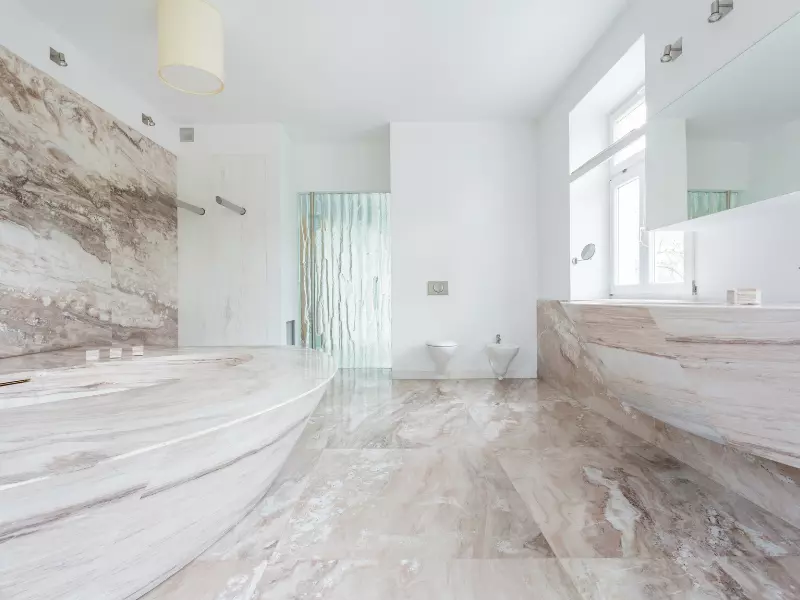Granite countertops are a timeless choice for kitchens and bathrooms, prized for their durability and...
Read MoreBathroom Granite Backsplash: Selection And Installation Guide

A bathroom granite backsplash is a luxurious and stylish addition to any bathroom, providing a durable and elegant surface that is easy to maintain. In this article, we will cover the benefits of installing a granite backsplash in your bathroom, as well as provide a comprehensive guide on how to install one yourself.
We will also compare the pros and cons of granite backsplashes vs tile, explain how to install an outlet in a granite backsplash, and offer tips on choosing a complementary tile backsplash for black fusion granite.
Finally, we will provide step-by-step instructions on how to install a granite backsplash installation both behind the bathroom sink and on a bathroom vanity. Whether you’re a seasoned DIYer or just starting out, this guide will help you achieve a stunning and functional bathroom upgrade.
Bathroom Granite Backsplash Vs Tile
When it comes to choosing between a bathroom granite backsplash and a tile backsplash, there are several factors to consider.
Here’s a comparison of the two options, along with their pros and cons:
Granite Backsplash:
- Pros:
- Durable and long-lasting
- Resistant to heat, moisture, and stains
- Easy to clean and maintain
- Adds a luxurious and elegant look to the bathroom
- Cons:
- More expensive than tile
- Difficult to install without experience
- Limited range of colors and patterns compared to tile
Tile Backsplash:
- Pros:
- More affordable than granite
- Wide range of colors, patterns, and textures to choose from
- Easy to install for DIYers
- Can create unique and personalized designs
- Cons:
- Requires regular maintenance to prevent stains and mildew
- Can be prone to cracking and chipping
- May need to be replaced more frequently than granite
When choosing between a granite and tile backsplash for your bathroom, consider your budget, desired style, and level of maintenance you are willing to commit to.
Granite is a more expensive option but requires less maintenance and is more durable, while tile is a more affordable and customizable option but requires regular maintenance to keep it looking its best.
Ultimately, the choice comes down to personal preference and what works best for your specific bathroom design and needs.
How to Install a Bathroom Granite Backsplash
If you’re ready to install a bathroom granite backsplash, follow these step-by-step instructions:
A. Tools and Materials Needed:
- Granite tiles or slabs
- Tile adhesive
- Caulk
- Tile spacers
- Level
- Measuring tape
- Wet saw or circular saw
- Notched trowel
- Grout float
- Grout sealer
- Sealant
- Safety goggles and gloves
B. Preparing the Area for Installation:
- Turn off the water supply to the bathroom sink.
- Remove any existing backsplash or tile.
- Clean the wall surface and ensure it is dry, level, and free of any debris.
C. Measuring and Cutting the Granite:
- Measure the area where you’ll install the granite backsplash.
- Transfer these measurements to the granite tiles or slabs, and mark where you need to make cuts.
- Use a wet saw or circular saw to cut the granite pieces to the appropriate size.
- Dry-fit the granite pieces in place to ensure they fit properly.
D. Applying the Adhesive and Installing the Granite:
- Apply tile adhesive to the wall with a notched trowel.
- Place the granite tiles or slabs onto the adhesive, using tile spacers to create even gaps between each piece.
- Use a level to ensure the granite is installed evenly and straight.
- Allow the adhesive to dry according to the manufacturer’s instructions.
E. Sealing and Cleaning the Backsplash:
- Remove the tile spacers and fill the gaps between the granite pieces with grout using a grout float.
- Wipe away any excess grout with a damp sponge.
- Allow the grout to dry according to the manufacturer’s instructions.
- Apply a grout sealer to protect the grout from staining and moisture.
- Apply a sealant to the granite surface to protect it from moisture and stains.
- Once everything is dry, remove any remaining adhesive or grout residue with a damp sponge.
By following these steps, you can install a beautiful and durable bathroom granite backsplash that will last for years to come.
Bathroom Granite Backsplash Outlet
If you’re installing a bathroom granite backsplash, you’ll need to consider how to incorporate electrical outlets into the design.
Here are the tools and materials you’ll need for cutting out an outlet in the granite backsplash:
Tools and Materials:
- Power drill
- Hole saw
- Tape measure
- Pencil
- Safety goggles and gloves
- Sandpaper or grinding wheel
- Caulk
Here are the step-by-step instructions for cutting out and finishing an outlet in your bathroom granite backsplash:
- Turn off the power supply to the electrical outlet you’ll be working on.
- Use a tape measure and pencil to mark the position of the outlet on the granite backsplash.
- Using a power drill with a hole saw attachment, carefully cut out a hole for the outlet in the granite.
- Check the fit of the outlet into the hole, making any necessary adjustments with sandpaper or a grinding wheel.
- Apply a bead of caulk around the edge of the outlet to create a waterproof seal.
- Reattach the outlet cover plate.
- Turn the power supply back on to the outlet to test the electrical connections.
By following these steps, you can install an electrical outlet in your bathroom granite backsplash, seamlessly integrating it into the overall design of the space. Be sure to take proper safety precautions when using power tools and wear protective gear to prevent injury.
What Tile Backsplash with Black Fusion Granite Bathroom
Choosing the right tile backsplash to complement black fusion granite can enhance the overall look and feel of your bathroom.
Here are some tips for choosing a complementary tile backsplash for black fusion granite:
- Consider the color: Since black fusion granite is a dark and bold statement, you may want to choose a tile backsplash in a neutral or light color to balance it out. Shades of white, cream, or beige can create a beautiful contrast against the dark granite.
- Look for texture: To add depth and dimension to your bathroom design, consider a tile backsplash with a textured finish. For example, a glossy subway tile or a matte-finish mosaic tile can create a visually appealing contrast against the smooth surface of black fusion granite.
- Mix and match: If you’re feeling daring, consider using a patterned or mosaic tile backsplash with black fusion granite. Just be sure to choose a tile that complements the colors and patterns in the granite to avoid clashing.
- Think about style: The style of your bathroom can also influence the tile backsplash you choose. For example, if you have a modern or minimalist bathroom design, a simple subway tile may be the best choice. However, if you have a more traditional or ornate bathroom design, a patterned or mosaic tile backsplash may work better.
Examples of tile options for a black fusion granite bathroom backsplash include:
- White subway tile
- Beige or cream-colored mosaic tile
- Gray marble tile
- Light blue glass tile
- Herringbone patterned tile
When choosing a tile backsplash for your black fusion granite bathroom, be sure to consider factors such as color, texture, style, and overall aesthetic.
By selecting the right tile, you can create a beautiful and cohesive bathroom design that complements the bold statement of black fusion granite.
How to Install Granite Backsplash in The Bathroom Sink or on Bathroom Vanity
Installing a granite backsplash behind the bathroom sink or on bathroom vanity can add a beautiful finishing touch to your bathroom design.
Here are step-by-step instructions for installing a granite backsplash in the bathroom sink or on bathroom vanity:
Tools and Materials:
- Granite slab
- Measuring tape
- Pencil
- Tile saw
- Silicone adhesive
- Caulk gun
- Grout
- Sponge
- Measure the space: Use a measuring tape to measure the length and height of the space where you want to install the granite backsplash. Record these measurements and use them to cut the granite slab to the appropriate size.
- Cut the granite: Using a tile saw, carefully cut the granite to fit around the sink and any other obstacles in the area. Be sure to wear protective gear such as safety goggles and gloves while working with the tile saw.
- Apply adhesive: Using a caulking gun, apply silicone adhesive to the back of the granite slab. Press the slab firmly against the wall, making sure it is level and flush with the countertop.
- Fill gaps: Use grout to fill any gaps between the granite and the countertop or wall. Use a sponge to wipe away any excess grout.
- Seal the backsplash: Once the grout has dried, use a sealant to protect the granite from water damage and stains. Follow the manufacturer’s instructions for application and drying time.
By following these steps, you can install a granite backsplash behind your bathroom sink or on bathroom vanity, adding a beautiful and functional finishing touch to your bathroom design. Be sure to take proper safety precautions while working with the tile saw and wear protective gear to prevent injury.
Conclusion
Are you tired of your outdated bathroom? Consider upgrading it with a beautiful and durable bathroom granite backsplash. Not only does granite add a touch of luxury to your space, but it also requires minimal maintenance and can withstand the wear and tear of daily use.
In this article, we’ve covered everything you need to know about choosing, installing, and maintaining a granite backsplash in your bathroom.
At SF Marble and Granite, we’re passionate about helping our clients create their dream homes. Our experienced team can guide you through the entire process, from selecting the perfect granite to expert installation. Contact us today to get started on your bathroom renovation project and discover the transformative power of a stunning granite backsplash.
FAQs Related Bathroom granite Backsplash
While it is possible to install a granite backsplash yourself, it’s a complex process that requires specialized tools and knowledge. It’s recommended that you hire a professional to ensure a proper installation and avoid costly mistakes.
To keep your granite backsplash looking like new, use a mild soap and warm water to clean it regularly. Avoid abrasive cleaners or tools that could scratch the surface. You should also seal your granite periodically to protect it from stains and damage.
It’s important to choose your granite carefully before installation, but if you’re not satisfied with the result, contact your installer to discuss possible solutions. Depending on the issue, they may be able to remove and replace the granite or make other adjustments.
Yes, a granite backsplash can work well in a small bathroom, as long as you choose the right color and pattern. Lighter shades and smaller patterns can make a space feel larger, while darker colors or large patterns can make it feel more cozy.
Our Services
Contact Us
- 755 Dutton St. Lowell-MA 01854
- Phone: 978-459-5823
- FAX: 978 459 5827
- smgranite@hotmail.com
Our Blogs
How to Repair Granite Countertops by Yourself
Granite countertops are renowned for their durability and timeless beauty. However, like any other surface,...
Read MoreBest Quartz Countertops with White Cabinets in 2024
In 2024, kitchen design continues to embrace clean, timeless aesthetics, with white cabinets and quartz...
Read More


